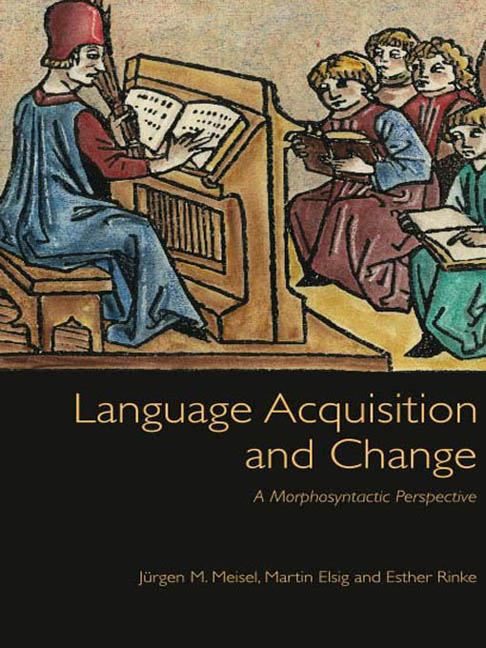Book contents
- Frontmatter
- Contents
- Preface
- Abbreviations
- 1 Variation and change in languages
- 2 Language change across the lifespan
- 3 The child as the locus and agent of grammatical change
- 4 Structural ambiguity as a possible trigger of syntactic change
- 5 Language contact as a possible trigger of change
- 6 Acquisition in multilingual settings: Implications for explanations of change
- 7 Towards an explanatory theory of grammatical change
- 8 References
- Index
3 - The child as the locus and agent of grammatical change
Published online by Cambridge University Press: 07 December 2017
- Frontmatter
- Contents
- Preface
- Abbreviations
- 1 Variation and change in languages
- 2 Language change across the lifespan
- 3 The child as the locus and agent of grammatical change
- 4 Structural ambiguity as a possible trigger of syntactic change
- 5 Language contact as a possible trigger of change
- 6 Acquisition in multilingual settings: Implications for explanations of change
- 7 Towards an explanatory theory of grammatical change
- 8 References
- Index
Summary
THE LANGUAGE-LEARNING CHILD AS THE LOCUS OF GRAMMATICAL CHANGE
The variability of language use, across and within individuals, suggests that we may be witnessing ongoing processes of language change, including changes in the domain of morphosyntax. If, however, we distinguish carefully – as we should do – between, on the one hand, possible change at the level of I-grammar, affecting the internal grammatical knowledge of native speakers of a particular language, and, on the other, change at the level of how this knowledge is put into use in communicative interaction, the question arises as to whether the observed variability indeed reflects change involving restructuring of grammatical knowledge. The discussion in the preceding chapter has led to the conclusion that this never happens across the lifespan of a native speaker of a language. Individuals certainly modify their speech habits in the course of their lives, adapting, for example, patterns of usage to alterations of the norms in the speech community. But no evidence has as yet been provided suggesting that this might affect the mentally represented grammatical knowledge acquired in early childhood; rather, this knowledge seems to be largely resistant to external influences. Assuming this claim to be correct, it inevitably leads to the conclusion that modifications of core properties of grammar can only happen in the course of transmission of grammatical knowledge from one generation to the next. Generational change quite obviously exists, i.e. community use can differ across generations, and such changes may affect morphosyntactic core features such as the setting of the verb movement parameter which determines the position of the finite verb in a clause; cf. Chapter 1. Yet if mature mental grammars are resistant to restructurings of this type, we must turn to developing grammars in order to be able to explain phenomena of this kind.
Note that this line of reasoning is based on the assumption that the results of psycholinguistic research can foster insights into the mechanisms underlying diachronic change. Although the relevance of acquisition research for explanations of diachronic change has long been acknowledged, it happens only very rarely that studies in historical linguistics actually take such insights into account.
- Type
- Chapter
- Information
- Language Acquisition and ChangeA Morphosyntactic Perspective, pp. 52 - 72Publisher: Edinburgh University PressPrint publication year: 2013



